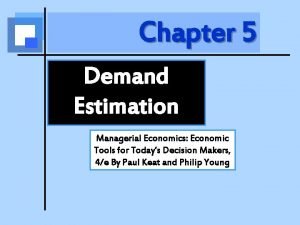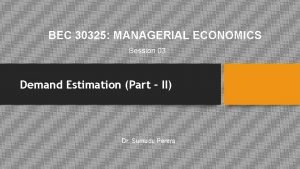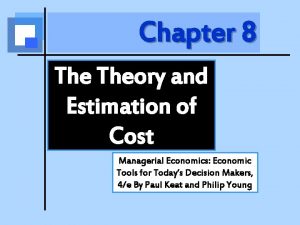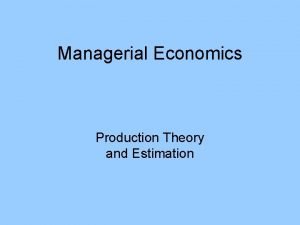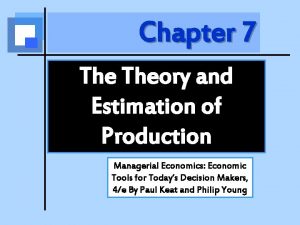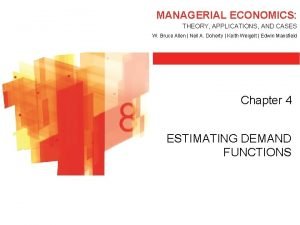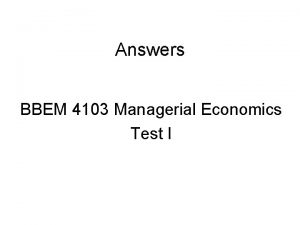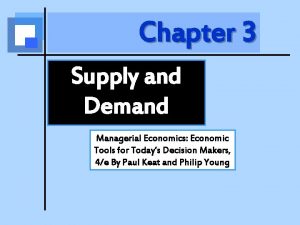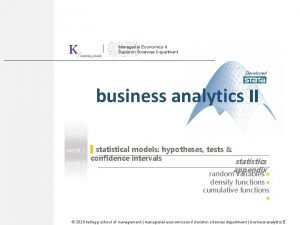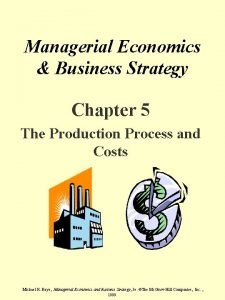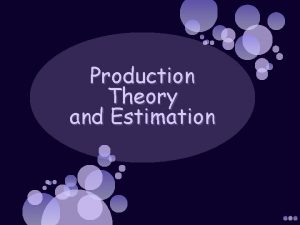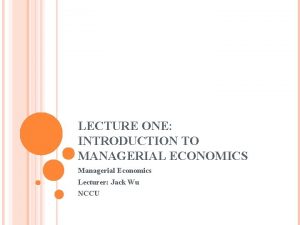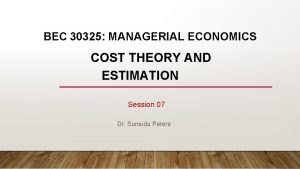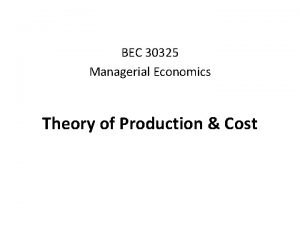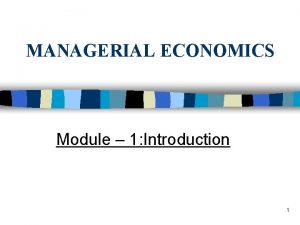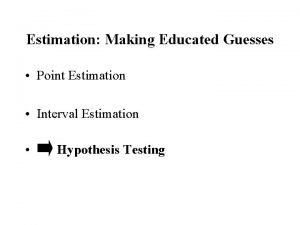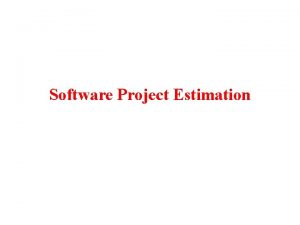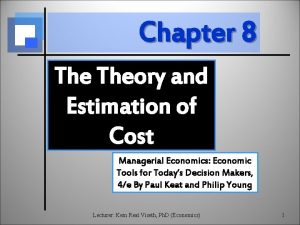Managerial Economics Production Theory and Estimation The Organization
























- Slides: 24

Managerial Economics Production Theory and Estimation

The Organization of Production • Inputs – Labor, Capital, Land • Fixed Inputs • Variable Inputs • Short Run – At least one input is fixed • Long Run – All inputs are variable

Production Function With Two Inputs Q = f(L, K)

Production Function With Two Inputs Discrete Production Surface

Production Function With One Variable Input Total Product Marginal Product Average Production or Output Elasticity TP = Q = f(L) TP MPL = L TP APL = L MPL EL = AP L

Production Function With One Variable Input Total, Marginal, and Average Product of Labor, and Output Elasticity

Production Function With One Variable Input

Production Function With One Variable Input

Optimal Use of the Variable Input Marginal Revenue Product of Labor MRPL = (MPL)(MR) Marginal Resource Cost of Labor TC MRCL = L Optimal Use of Labor MRPL = MRCL

Optimal Use of the Variable Input Use of Labor is Optimal When L = 3. 50

Optimal Use of the Variable Input

Production With Two Variable Inputs Isoquants show combinations of two inputs that can produce the same level of output. Firms will only use combinations of two inputs that are in the economic region of production, which is defined by the portion of each isoquant that is negatively sloped.

Production With Two Variable Inputs Isoquants

Production With Two Variable Inputs Economic Region of Production

Production With Two Variable Inputs Marginal Rate of Technical Substitution MRTS = - K/ L = MPL/MPK

Production With Two Variable Inputs MRTS = -(-2. 5/1) = 2. 5

Production With Two Variable Inputs Perfect Substitutes Perfect Complements

Optimal Combination of Inputs Isocost lines represent all combinations of two inputs that a firm can purchase with the same total cost.

Optimal Combination of Inputs Isocost Lines AB C = $100, w = r = $10 A’B’ C = $140, w = r = $10 A’’B’’ C = $80, w = r = $10 AB* C = $100, w = $5, r = $10

Optimal Combination of Inputs MRTS = w/r

Optimal Combination of Inputs Effect of a Change in Input Prices

Returns to Scale Production Function Q = f(L, K) Q = f(h. L, h. K) If = h, then f has constant returns to scale. If > h, then f has increasing returns to scale. If < h, the f has decreasing returns to scale.

Returns to Scale Constant Returns to Scale Increasing Returns to Scale Decreasing Returns to Scale

Empirical Production Functions Cobb-Douglas Production Function Q = AKa. Lb Estimated using Natural Logarithms ln Q = ln A + a ln K + b ln L
 Cost theory and estimation
Cost theory and estimation Demand forecasting methods in managerial economics
Demand forecasting methods in managerial economics Demand estimation in managerial economics
Demand estimation in managerial economics Demand estimation in managerial economics
Demand estimation in managerial economics Estimation of cost function in managerial economics
Estimation of cost function in managerial economics Production theory and estimation
Production theory and estimation Production theory and estimation
Production theory and estimation Managerial economics: theory, applications, and cases
Managerial economics: theory, applications, and cases Pengertian pre production
Pengertian pre production Game theory managerial economics
Game theory managerial economics Discuss the nature and scope of managerial economics
Discuss the nature and scope of managerial economics Managerial economics meaning and definition
Managerial economics meaning and definition Managerial economics test questions and answers
Managerial economics test questions and answers Oikonomikos meaning
Oikonomikos meaning Scope of managerial economics
Scope of managerial economics How managerial economics is useful to engineers
How managerial economics is useful to engineers Managerial economics applications strategy and tactics
Managerial economics applications strategy and tactics Supply analysis in managerial economics
Supply analysis in managerial economics Certainty equivalent
Certainty equivalent Managerial economics and decision sciences
Managerial economics and decision sciences Incremental principle
Incremental principle Managerial economics:
Managerial economics: Managerial economics chapter 5
Managerial economics chapter 5 Fundamental concept
Fundamental concept Pricing methods in managerial economics
Pricing methods in managerial economics


